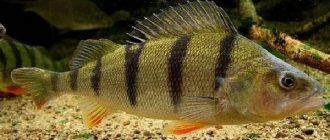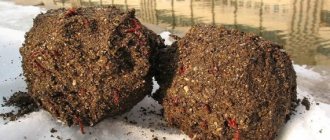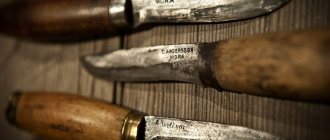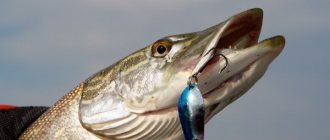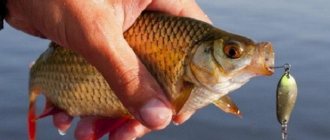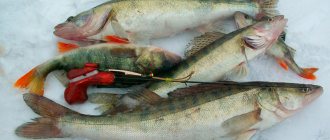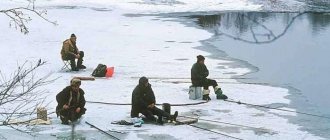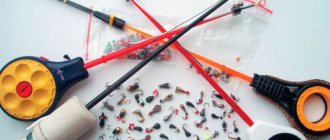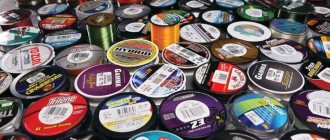Content:
- 1 What is a spinner?
- 2 Types of spinners
- 3 Finnish lures
- 4 When is the best time to fish with a spoon?
- 5 Fishing for pike, perch, pike perch 5.1 Fishing for pike with winter lures
- 5.2 Catching perch with a spoon
- 5.3 Winter fishing for pike perch using spoons
Most winter fishing enthusiasts prefer to use handmade baits. What kind of baits these are and how to use them will be described in this article.
What is a spinner?
A spoon is an artificial bait for fish, equipped with a hook or several hooks. Spoons are made from metal such as copper, brass, stainless steel and others. As a rule, the shape of the spoon resembles a small fish and can be painted to match the color of a certain type of fish: pike, bleak, etc. Recently, you can find artificial baits that imitate small animals, such as mice, frogs, leeches, and crustaceans.
Types of spinners
Artificial baits (spinners), depending on the fishing season, are divided into:
Summer.
These are basically oscillating and rotating spoons.
Winter.
They have several subspecies:
- Spoons for vertical
trolling. - Spoons in the form of a rocker
- balancers. - Spinner " Dragon
". This is a lure that is often used by poachers, and the fishing method can easily be called “draconian”.
Summer and winter have a significant difference due to the nature of the application. If in summer the lure is held horizontally, then in winter it is only carried out vertically, since you have to fish from the ice.
Depending on the characteristics of fishing, a winter fishing rod is also selected. When fishing with a jig, it is advisable to have a winter fishing rod with a sensitive nod. When fishing with a spinner, a nod is not necessary. Although, if you look from the other side, a winter fishing rod is a very primitive tackle, regardless of what type of bait is used.
Certain lures are used to catch a specific type of fish. For example, in a fishing store you can find lures for pike, as well as lures for perch. Moving in the water (playing), the winter lure imitates the behavior of a small fish, attracting the attention of predator fish. You can catch fish all year round with good lures. In the warm season, spinning rods are usually used, and when the water is covered with ice, winter spinners are used. In this case, the following technique is used: winter lures are lowered strictly vertically down, preferably to the very bottom, and with the help of constant twitching the desired effect is achieved - a good bite. What is the difference between winter lures and summer ones? The most important difference that distinguishes winter lures is their design. Firstly, winter spoons are narrower than regular ones. Secondly, winter lures are distinguished by their special action, which is usually achieved by shifting the center of gravity. Anglers also classify spinners for winter fishing according to the types of fish they are intended for catching. Spoons for perch are small and light, 2-4 cm long. Winter spinners for catching pike are made wider and elongated (4-11 cm). Previously, back in Soviet times, there was not such a variety of products for fishing as there is today. At that time, not everyone could buy a spinner, Winter fishing rods, because they simply were not on sale. Winter fishing rod . I had to make my own spinners, Winter spinners for perch, Winter spinners for pike perch. Today, the problem is not to buy Winter spinners for perch, Winter spinners for pike perch, but in choosing spinners from the variety that we see on store shelves for anglers. Winter spinners come in different types, shapes and sizes. When choosing Winter lures, you should remember that each type of lure requires a special technique for placing the bait, so you should not try to buy all types of lures - limit yourself to a few models and improve your ability to use them. All spoons can be divided into several groups: oscillating spoons, bottom spoons, vibrating spoons, wobblers and rotating spoons. Oscillating spoons are the oldest and simplest bait, highly effective. You can find such spinners in the arsenal of almost every spinning player. Spinnerbaits - as they are affectionately called by fishing enthusiasts - are distinguished by their special game: a moving spoon of this type imitates a live fish very well: they swing from side to side, without rotating or making any other movements unnatural for fish.
Spinner for perch.
Winter lures for pike, lures for perch will not leave these types of fish indifferent and will bring you a good catch. Spinner baits come in a variety of shapes, sizes and weights. Depending on the depth at which fishing takes place, the weight and size of the spinners are selected - these parameters greatly influence the performance of the spinner. For example, if you are fishing for large fish at depth, a spinner with a weighted body will suit you. Such a spinner for pike attracts predators with color highlights and acoustic waves generated when the spinner rotates. To provoke a pike to bite, lures for pike need to be lifted from the bottom slowly and evenly. If this does not help, perhaps a pike spoon of a different color or shape will help you. There is also a pike spinner with a weighted head, due to which the spinner rotates even when you pause in reeling. The lure for perch is small and light. Rotating and producing flickering and noise, the lure for perch gives excellent results even in the hands of a novice angler. Before being put into production, our spinners undergo thorough testing in real conditions. The testing process goes as follows. First, we make several test spinners, which are then tested throughout the year in different regions: both in winter (from ice) and in summer (from boats). Experienced fishermen fish with these samples and leave us their feedback. After such preliminary testing, the spinners that receive the highest ratings are put into production. Each of our spinners has its own unique action that attracts large fish, allowing you to get an excellent catch. To make a good lure, experience alone is not enough - you also need high-quality materials. We make spinners from non-ferrous metals, the main ones being copper, brass, cupronickel. We also produce exclusive silver spoons and gold spoons. To make spinners, we use fittings from famous brands known to every angler - Owner and Cannelle. In addition to amateur fishermen, our lures are also in demand among athletes. Thanks to some of our spinners, their owners were able to win prizes in various competitions. If you make homemade spoons and want to improve your skills, our site will also be useful to you. At the moment, photographs of our spinners are displayed on the website, and in the future it is planned to open a blog where you can get useful information from a fisherman with forty years of experience about what materials and how to make spinners. Winter spinners, Winter spinners for perch, Winter spinners for pike perch, Winter spinners video, Spinner for pike, Spinner buy, Good spinners, Winter fishing rod, Spinner buy, Winter fishing, Pike fishing, Fishing for pike perch, Spinner, Spinner buy
Finnish spoons
Finnish manufacturers of spinners produce excellent models and have proven themselves to be the best. Such models can be considered:
- Nautilus has a peculiar shape, in the form of a narrow pear.
- Alaska, has a narrow purlin shape.
- Veteran, there is a blade at the back of this bait.
- Caravelle is somewhat reminiscent of a squid due to the wings located at the back of the spoon.
Finnish spoons are characterized by excellent play and a unique shape, as well as a unique tee attachment.
Williams-shaped spinners should be highlighted separately. It was organized in 1916 by the Williams brothers. These spoons have no analogues, so they can be recommended for a wide range of winter fishing enthusiasts. The body of the spoon is made of polished brass, after which a thin layer of gold or silver is applied to it.
Oscillating spoons
Oscillating spoons have a large mass, which allows the angler to make a good, long cast. By size they are divided into large and small. They are ideal to use when fishing for pike and sometimes pike perch. In the fall, when pike gain fat, you can catch them using large spoons. In the spring, when the pike has lost weight, it can be fished with small spoons. Oscillating spoons are not universal. For example, catching chub with a spoon is problematic. This type of spinner has been used by fishermen since ancient times. Now that the range of fishing lures has expanded significantly, the popularity of oscillating spoons has decreased. Despite this fact, when fishing for asp, oscillating spoons have no equal, since this type of fishing requires accurate, long-range casting.
This article briefly summarizes information about spinning baits - spoons. We will talk about other baits, such as wobblers and silicone baits, in other articles.
Thank you all for your attention! No tail, no scales, fishermen!
Source
When is the best time to fish with lures?
Fish respond well to the play of spinners at the beginning and end of winter. Large specimens are mainly caught using lures. If there are no bites, then this is a signal indicating a transition to the next hole. There can be 10 such holes, depending on the nature of the reservoir. This is especially true when fishing is carried out in an unfamiliar body of water. Sometimes, to find fish, you have to drill a large number of holes. Unfortunately, this is the specificity of winter fishing.
Fishing for pike, perch, pike perch
Catching pike with winter lures
The gear for winter pike fishing is somewhat different from the gear used for catching other types of fish. First of all, it should be noted that this is a toothy predator that can easily bite the fishing line.
Therefore, the presence of a metal leash is mandatory. A pike of any size can bite, which must be taken into account. Based on this factor, you should select the main elements of gear, such as a fishing rod and fishing line. The rod should be powerful, to which the fishing line is attached, 0.3-0.4 mm thick. When fishing for pike, the bite can be determined using your hand.
Winter pike fishing is possible with various spinners, differing in:
- Constructions.
- Size.
- Form.
- Blossom.
- The nature of the game.
The principle of winter lure fishing is based on the imitation of a small fish that can attract any predator, including pike. There are hooks attached to the spoon. For pike fishing, treble hooks (tees) are more suitable, as they are more reliable and catchy.
The size of the spoon plays an important role. Typically, these are spinners with a length of 6 to 12 cm.
Before you can catch a pike in winter, under thick ice, you will have to find it. To do this, it is necessary to drill a certain number of holes and try to determine the nature of the bottom topography. The task can be greatly simplified if you use an echo sounder. But this does not mean that you will not have to drill holes. You will have to punch holes, although there may be much fewer of them.
Catching perch with a spoon
Perch prefers to be in a school, so if you catch one striped robber, you can count on a serious catch. But you can’t hesitate, so the spinner will help you quickly carry out the fishing process. The spoon attracts perch due to its action, shape and size. The action of the bait resembles the movements of a small fish, and its shine provokes the perch to attack.
Perch, like other types of fish, tries to find a deep-sea place in order to survive the winter without any problems. Here he chases “trifles”, which is a source of food. Perch can easily be called a smart predator. Before he decides to attack, he can study potential prey for a long time and only then rush at it and swallow it. Therefore, the game of the spinner should be believable and natural.
The game of the spinner comes down to the fact that it is lowered to the bottom, after which, with a sharp movement, the spinner rises to a height of 30-35 cm. As soon as the spinner is at the top point, the fishing rod is lowered, and the spinner “planes” to the bottom. When you reach the bottom, you need to take a pause. The key to successful winter fishing depends on the organization of constant breaks.
Winter fishing for pike perch with spoons
Catching pike perch in winter deserves special attention. It's interesting and entertaining. At the same time, it does not require a special leash, as when fishing for pike, despite the fact that a serious specimen can bite, unlike catching perch.
Despite the fact that winter pike perch is not as active as summer pike perch, a good catchable spoon will always be able to interest such a predator as pike perch. Very often, to catch it, they use a balance spinner with a peculiar game. The spinner is made in the shape of a fish with different colors. The question is which coloring he will prefer. The balancer is carried out in the same way as when catching perch: it is sharply raised up, 40 centimeters, after which it is allowed to smoothly lower to its original place. The game of the balancer in free fall is very important. It was then that his movements resemble those of a small fish. A pike perch can attack a spinner either while it is falling or when it stops at the lowest point. When you reach the bottom point, you should stop for a few seconds so that the pike perch does not miss.
Sometimes, pike perch perceives the spinner as an object for play. At the same time, he can attack the bait at any time. You must always be prepared for this turn of events.
Summer lures for winter fishing
I have read and heard more than once that the “shakers” that we usually put on spinning rods in the summer are great for catching even in winter from under the ice. And while preparing for my next trip to the ice, I came across the Kuusamo Professor 4 spinner (length 50 mm, weight 6 g) - copper on the front side and silver on the back. I remember from summer fishing that this model requires the lightest leash and a very slow retrieve. And due to its small size, it tempts a variety of predators - pike, perch. Usually I do a little “tuning” - I remove the top ring altogether (the leash fastener is enough), put on a bottom ring with a diameter of 5 - 6 mm, and a tee that is thinner than the “original” one and no wider in size than a spinner. Then the “play” of the spinner becomes even more lively, especially when falling (due to its lightness, when retrieved, it strives to rise to the upper layers, so I use Stop and Go). In general, it’s a worthwhile spinner. What are the prospects for flashing it in winter?Like many anglers, by “winter trolling” I mostly mean catching bass. Here, the most important stage of the “game” for winter models will be the falling phase, not the pulling phase. But summer spinners require a special approach, because they can work well not only when falling - with the right smooth swing they also “play”, which additionally attracts fish, and not just striped ones. You just need to select such a swing speed that the spinner works as with a summer step-by-step retrieve. Experience shows that winter pike appreciates this, and pike perch often hangs.
I will also note that when catching a passive predator, you need to excite it as much as possible, and the “double play” of the Kuusamov spinner - on the swing and on the fall - better achieves this effect. An intense “game” can also help when catching dispersed active perches that need to be attracted from a large area. But the “game” itself and even attracting fish does not guarantee that it will bite, so the selection of the equipment of the spoon and its color also matters. Before fishing, I installed “perch” rings and tees on the lure, experimentally selecting them so that both phases of the “game” - on the swing and on the fall - were the most stable and clear.
Since the “game” of the Professor 4 spinner is unusual, the technique of working with a fishing rod, traditional for winter lures, does not fully reveal its capabilities. I have selected several variants of swings in which the spinner has a different “game”. With a short swing with an amplitude of about 10 - 15 cm, lateral deviation is observed not during the fall, but during the ascent. And when it is possible to consistently reproduce this swing, the spinner begins to scour from side to side. When falling, the spoon moves horizontally with transverse vibrations, returning to the center of the hole. Then several damped oscillations occur in the transverse plane. I observed such a “game” at depths of up to two meters. Well, at greater depths, it seemed to me, the movements of the bait became less active. But even at depths of up to 4.5 m, perches pecked at Professor 4. By the way, I used a fishing line no thicker than 0.2 mm, so as not to interfere with the “play” of the spinner at depth.
I took several more Kuusam summer models with me to the ice, and among them was Professor 2 (90 mm, 13 g) in a “brass-silver” side combination (photo). In summer, this lightweight spoon works effectively in shallow waters, and in the “non-snagging” version it is good for catching rare reeds and large-leaved vegetation. Due to its low weight, the Finnish “Professor” allows for the slowest wiring and frequent stops. Pike often take a pause when the spoon, sparkling on its sides, slowly sinks. Since in the summer this spoon catches on the retrieve and on the fall, why not use it for winter pike?
Having put Professor 2 on the fishing rod, I found out that its “game” differs from its smaller brother Professor 4. I did not detect any significant horizontal deviations to the sides during a short stroke. When the spoon sank, it waddled, swaying on its sides and slightly deviating from the vertical axis of its fall in the transverse and longitudinal directions. The fall speed is just over half a meter per second. After moving to a vertical position, the spoon makes a few more wobbling movements with its sides and calms down. In general, after one smooth swing per meter, the full cycle of the “game” before stopping is about 15 seconds. The indicators, of course, are approximate, since the influence of depth is very clearly expressed - say, at two and a half meters, the “game” is much simpler and less active in terms of small fluctuations. The minimum depth where it is possible to fully “launch” the spoon is about 40–50 cm of clean water under the ice. In shallow water, this light spoon can be thrown with a short, smooth swing with an amplitude of about 30 cm - and it manages to lie down in a horizontal plane and begin the “game” on the fall.
When you hunt for pike, you have to cast your bait blindly. Landmarks that help with catching perch do not work. All you need to do is drill hole after hole. And believe in the spinner. After all, when after the next ten holes you begin to think that the fish are not biting because of the moon, the weather or something else, there are no worries “maybe the spinner is wrong,” because it has been verified: Professor 2 is a working spinner.
I also tried a model from Kuusamo - Rasanen 70/10 (70 mm, 10 g - photo 5). There are many legends about the summer catchability of this particular spoon, but there are also many fakes for it. What happens is that Asian copies of famous baits work well. But when it comes to winter lures, it is better not to take risks - and take an original bait, the quality of which has been tested for many years of fishing all over the world.
As for the “game” of this bait under the ice, during a short and sharp swing it moves slightly to the side, which is quite stable. When falling, there is also a deviation from the vertical axis, and the spoon darts away from the hole, then stops - and falls without deviation to the sides, swaying on its sides. On a short stroke with an amplitude of 7 - 8 cm, even in a 30 - 40 cm layer of water under the ice, it already gives out some kind of independent “game” pattern. We must not forget that Rasanen spinners are classics of the Finnish genre. And for a beginner, it is also a factor due to which he can sometimes catch skilled fishermen. After all, if you fish with proven baits, you will definitely be lucky (photo).
Also among the test subjects was a pair of Kuusam Rasanen 50/11 models (50 mm, 11 g) - in a copper-silver combination and the same color, but with black stripes on the front side. In the summer, these lures worked for me on pike both at shallow depths (2 - 3 m) without a current, and in weak currents in small rivers at depths of up to one and a half meters.
The “native” tee on spinners is not a perch tee at all, there are no “impact points” there (it is in the form of a red bead only on the body of the spinner itself). And on the Internet, Rasanen 50/11 appeared exclusively in reports from Finnish anglers about successful winter trolling of pike and pike-perch. Therefore, without much hope, I took these models on my next fishing trip in the Gulf of Finland - perch, without making any changes to the fittings in order to check their performance “as is”.
In one of the bays on the southern coast of the Gulf, the ice stood reliably and unshakably. There were no special trophies observed there; on average, the size of the perch that came across was about 100 g, although a few were under 300 g. But the main thing is that the “stripers” were taken consistently. And I decided to try the Finnish bait on a hot perch. The very first retrieve, pause - I feel a weak strike on the spoon. After a couple of wires, another touch. Having made another swing and dropped the lure, during a pause I swung it a little, literally half a centimeter - and immediately someone responded from the other side of the fishing line. I hooked and got a perch. Apparently, he himself did not expect that he would bite - he barely pinched one of the bends of the tee. That day it was not possible to catch any more fish with this lure. I must admit, I was not aware of what wiring would be correct for this model; it behaved atypically for winter spinners on the swing and on the fall. I tried different wiring in the holes where perch had previously bitten on winter “verticals”, but only sometimes felt the strikes on the spoon.
The next day I went there. I slightly “tuned” the Rasanen 50/11 spinners by changing the “impact point”: I removed the bead (this is done easily, as is putting it back in place) and put bright silicone cambrics on the tees (photo). And it worked - we managed to catch 7 perches in different holes. Working with this spoon is the simplest: smooth rises and drops. Both combinations of several strokes with simultaneous lifting, and teasing the perches by changing the duration of pauses worked. The spinner has a stable and uniform “game” during the fall - it slowly sinks with its concave side towards the bottom with smooth swaying of the sides. No side deviations were observed. The sharpness of the swing led to the fact that the bait rose with significant resistance and seemed to rotate - just as happens in the summer when the retrieve is too fast. And this was not welcomed by the perches - they took it when the stroke was smoother than with ordinary winter lures.
And at the end, a few words about the gear used for all Kuusam models. The same fishing rods that I usually use for fishing were suitable for perch. For pike - fishing rods with a reel and a strong whip about 50 cm long, fishing line - from 0.3 mm (where the bottom is clean) and up to 0.5 mm (in snagged places).
Arthur Gabdrashitov
Making a winter spinner with your own hands
Many, especially experienced fishermen, make their own spinners. This process is as interesting as the process of fishing itself. With the proper approach and care, you can make a very catchy specimen. In addition to being interesting, it is also not expensive. Everyone knows that all catchable models are not cheap and most anglers cannot afford such luxury. It is also a known fact that many cheap models are not easy to catch. Very often, homemade spinners easily compete with their expensive originals. It all depends on the skill and skill of the one who makes the bait.
It’s quite easy to make a lure like the “Torpedka”. She is capable of some interesting movements. Copper strips 0.2 mm thick are suitable for its manufacture.
The “torpedo” is made by extrusion, after which the cavity is filled with solder.
Winter lures for perch
A wide variety of fishing gear is used in winter. Some are designed to attract fish in shallow waters, while others are great for deep-sea play. Heavier spoons are used in reservoirs with strong currents, and lighter ones are used where there is practically no current. Lures with a wide profile are suitable for fishing in shallow water: they are light in weight, sink slowly to the bottom and have time to deviate sufficiently from the dive site.
|
When the winter season reaches its peak, perch and humpback must be lured in deep water. This accordingly requires changing the bait, which will now be thinner and heavier. Such a spinner will provide stable and heaped play at decent depths and places with strong currents.
Those fishermen who prefer to purchase bait in stores can pay attention to the assortment of Finnish products, as well as a number of other Scandinavian countries. Polish and Baltic spinners are of good quality. Domestic products are also decent. Below in the article we will present a selection of the best baits, and for those who prefer to make their own, detailed instructions will be given.
